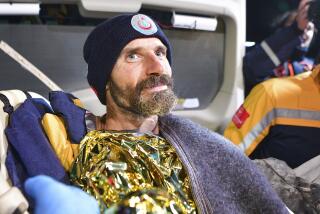Ex-Patient Helps Lift the Spirits of Others : Recovery: Steven Dimmick spends up to four days a week on the third floor at the hospital in Hawthorne. The staff lauds his efforts.
- Share via
When Steven Dimmick burned his little toe on a campfire a few years ago, he never thought that it would lead to gangrene, a partial amputation of his foot, impaired eyesight and five months in the hospital. But as much as he lost in the experience, Dimmick found something too: humanity.
During his 1992 stay at Robert F. Kennedy Medical Center in Hawthorne, he spent a good deal of time helping other patients cope with depression. Dimmick, 29, is still on the road to recovery, but he continues to spend three and four days a week on the hospital’s third floor, helping lift the spirits of those who need it.
Dimmick says he helps himself feel better by helping others. He gets the guy in traction a banana that the nurses don’t have time to fetch. He plays cards. He talks. He offers suggestions--based on his own experiences--on how to cope with the long hospital days and nights.
“Steve is wonderful,” said Julia Johnson, director of activities for the hospital recreational therapy program on the third floor. “He’s so loving, warmhearted and caring. He gives a lot of himself to patients and to the staff. He’s always there to assist us.”
She said the other patients feel comfortable with him. “They feel his kindness. He gives them a little extra tender loving care, a little extra time. That makes them feel good about themselves. Just being there to share with the other patients and letting them know, ‘Hey, you’re not alone. I’ve been going through it for years.’ That’s a good feeling.”
Dimmick, who lives in Gardena, calls the hospital his “home away from home.” His eyes fill with tears when he remembers the day he was discharged. “That staff did so much for me,” he said. “I wanted to return the favor.”
Hospitals were the furthest thing from his mind in December, 1991, when he burned his toe. He and his friends were sitting around the campfire, drinking and talking, when he casually moved a metal lawn chair with his bare foot. He didn’t realize that the chair had been close to the fire and that the metal was hot enough to burn his skin.
A diabetic since age 11, Dimmick knew how important it was to make sure that the wound healed. Because of blood sugar imbalances, diabetics are much more susceptible to chronic infection and eventual gangrene than are non-diabetics, he said. “But I wasn’t too worried,” he said, because he had previously had numerous scrapes, burns and blisters without problems.
A few days later, the blister was nearly gone. Then Dimmick got the flu. For five days, he lay in bed, not even feeling well enough to take off his socks. When he did, he was horror-stricken: Nearly half of his left foot was black.
“I was hoping my brother had played a practical joke on me,” he said. “I yelled at him, ‘Please tell me you painted my foot black, please tell me!’ But he said he hadn’t.
“I never thought this could happen to me, especially from a little blister.”
Despite more than a dozen surgeries, Dimmick lost only a small part of his foot. And although his eyesight was damaged because of a complication of the diabetes, he has regained most of his sight. He is learning to walk again and hopes to go back someday to his job as a union carpenter.
“If I had to do it all over again, I’d probably become a doctor,” he said. “In my work, I can finish building something and say, ‘I built that,’ and it’s a neat feeling. But it’s not the same as seeing people feel better or look better. I get more satisfaction from seeing people laugh.”
More to Read
Sign up for Essential California
The most important California stories and recommendations in your inbox every morning.
You may occasionally receive promotional content from the Los Angeles Times.













